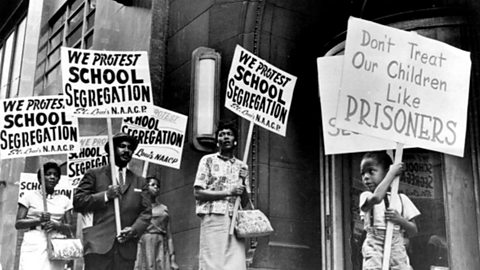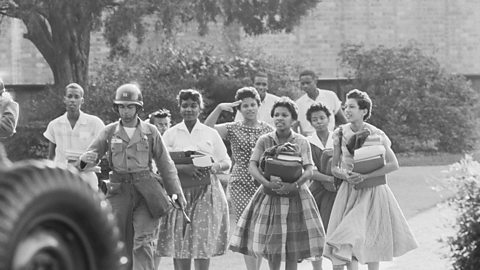Civil rights - school desegregation
African Americans had always resisted and struggled for racial equality and justice. However, in the 1950s and 1960s, the activism of several organisations and communities made significant strides towards freedom in access to education.

Segregation laws
Legal racial segregationThis meant that white people and black people had to live separately. The areas of society affected by segregation included churches, hospitals, theatres and schools. had been upheld by the United States Supreme CourtThe highest court in the USA. It has the power over all courts in the country. in the 1896 Plessy v Ferguson case. The court ruled that African Americans could be "separate but equal". This led to the solidifying of Jim Crow lawsThe laws that introduced segregation in the US South (the laws that kept black people and white people apart). in the South and of racist cultures across America. Segregation was legally protected, so African Americans and activists had to struggle against it.
School desegregation
The National Association for the Advancement of Colored People NAACPThe National Association for the Advancement of Colored People was created in 1909 to eliminate race-based discrimination across the United States of America. used a range of tactics, including litigationThe process of taking a case to court so that a judgement can be made. to fight for equality. In 1954 the NAACPās lawyers won the school desegregationRemoval of laws that separate people from different races in public places and day-to-day life. Supreme Court case known as Brown v Board of Education. The court ruled that "separate but equal had no place in education". This ruling only applied to schools. However, it showed that segregation generally was losing its lawfulness.
The Little Rock crisis, 1957
After the Brown v Board of Education ruling, only some school boards began to desegregate their schools, and they did so slowly. This was because the Supreme Court had not given a specific timeframe for desegregation to happen. Additionally, some cities and communities refused to comply with the ruling.

The local school board in Little Rock, Arkansas, decided to proceed with school desegregation. In September 1957, supported by local NAACP branch leader Daisy Bates, nine African American students attempted to attend Central High School in Little Rock.
There was a fierce backlash in the local community. White Citizensā CouncilGroups of white supremacists, who worked together to stop desegregation. organised against the desegregation of Central High School. On the first day of the school term, a large angry mob gathered outside the school to show their opposition to desegregation and to intimidate the African American students. Two of the students who attended Central High School in Little Rock were Elizabeth Eckford and Minnijean Brown.
The governorA person who is elected to lead a stateās government in the USA. of Arkansas, Orval Faubus, upheld segregation by using the Arkansas National Guard to stop the nine African American students from attending Central High School. This was illegal. To resolve the crisis, President Dwight D Eisenhower intervened to ensure the Little Rock Nine could attend Central High School.